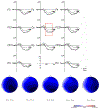Psycholinguistic mechanisms of classifier processing in sign language
- PMID: 33211523
- PMCID: PMC8272559
- DOI: 10.1037/xlm0000958
Psycholinguistic mechanisms of classifier processing in sign language
Abstract
Nonsigners viewing sign language are sometimes able to guess the meaning of signs by relying on the overt connection between form and meaning, or iconicity (cf. Ortega, Özyürek, & Peeters, 2020; Strickland et al., 2015). One word class in sign languages that appears to be highly iconic is classifiers: verb-like signs that can refer to location change or handling. Classifier use and meaning are governed by linguistic rules, yet in comparison with lexical verb signs, classifiers are highly variable in their morpho-phonology (variety of potential handshapes and motion direction within the sign). These open-class linguistic items in sign languages prompt a question about the mechanisms of their processing: Are they part of a gestural-semiotic system (processed like the gestures of nonsigners), or are they processed as linguistic verbs? To examine the psychological mechanisms of classifier comprehension, we recorded the electroencephalogram (EEG) activity of signers who watched videos of signed sentences with classifiers. We manipulated the sentence word order of the stimuli (subject-object-verb [SOV] vs. object-subject-verb [OSV]), contrasting the two conditions, which, according to different processing hypotheses, should incur increased processing costs for OSV orders. As previously reported for lexical signs, we observed an N400 effect for OSV compared with SOV, reflecting increased cognitive load for linguistic processing. These findings support the hypothesis that classifiers are a linguistic part of speech in sign language, extending the current understanding of processing mechanisms at the interface of linguistic form and meaning. (PsycInfo Database Record (c) 2021 APA, all rights reserved).
Conflict of interest statement
Conflict of Interest Statement
The authors report no conflicts of interest.
Figures


Similar articles
-
Subject preference emerges as cross-modal strategy for linguistic processing.Brain Res. 2018 Jul 15;1691:105-117. doi: 10.1016/j.brainres.2018.03.029. Epub 2018 Apr 5. Brain Res. 2018. PMID: 29627484
-
Iconic gestures serve as manual cognates in hearing second language learners of a sign language: An ERP study.J Exp Psychol Learn Mem Cogn. 2020 Mar;46(3):403-415. doi: 10.1037/xlm0000729. Epub 2019 Jun 13. J Exp Psychol Learn Mem Cogn. 2020. PMID: 31192681
-
Age of acquisition effects differ across linguistic domains in sign language: EEG evidence.Brain Lang. 2020 Jan;200:104708. doi: 10.1016/j.bandl.2019.104708. Epub 2019 Nov 4. Brain Lang. 2020. PMID: 31698097 Free PMC article.
-
On language acquisition in speech and sign: development of combinatorial structure in both modalities.Front Psychol. 2014 Nov 11;5:1217. doi: 10.3389/fpsyg.2014.01217. eCollection 2014. Front Psychol. 2014. PMID: 25426085 Free PMC article. Review.
-
Processing a dynamic visual-spatial language: psycholinguistic studies of American Sign Language.J Psycholinguist Res. 1993 Mar;22(2):153-87. doi: 10.1007/BF01067829. J Psycholinguist Res. 1993. PMID: 8366475 Review.
Cited by
-
Low-Frequency Entrainment to Visual Motion Underlies Sign Language Comprehension.IEEE Trans Neural Syst Rehabil Eng. 2021;29:2456-2463. doi: 10.1109/TNSRE.2021.3127724. Epub 2021 Dec 3. IEEE Trans Neural Syst Rehabil Eng. 2021. PMID: 34762589 Free PMC article.
References
-
- Baggio G, & Hagoort P (2011). The balance between memory and unification in semantics: A dynamic account of the N400. Language and Cognitive Processes, 26(9), 1338–1367.
-
- Battison R (1978). Lexical borrowing in American Sign Language. Silver Spring: Linstok Press.
MeSH terms
Grants and funding
LinkOut - more resources
Full Text Sources
Research Materials

